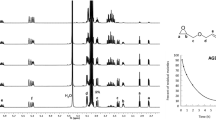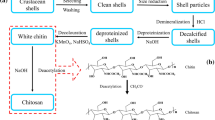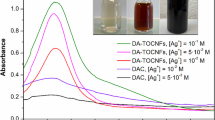Abstract
The adsorption behavior of polyelectrolyte complexes (PECs) of poly(allylamine hydrochloride) (PAH) and 4-O-methylglucuronoxylan (Xyl) onto silica surface, cellulose nanofibrils (CNFs) model surfaces, and unbleached softwood kraft fibers was studied. Different charge ratios and ionic strengths of the liquid medium (q − /q +: 0.3, 0.5 and 0.8 in 1 mM NaCl, and q − /q +: 0.2, 0.3 and 0.5 in 10 mM NaCl), at pH 7.5 were considered. First, the complexes obtained were characterized by measuring the charge density, the particle size and the zeta potential. Then, the adsorption of PAH alone and PECs on silica and CNF model surfaces were studied by quartz crystal microbalance with dissipation monitoring (QCM-D) and surface plasmon resonance (SPR). The QCM-D test indicated that: (a) adsorbed cationic layers of PECs were soft in 10 mM NaCl, (b) higher adsorption was observed at higher ionic strength and (c) the highest adsorption of complex and coupled water was found at a charge ratio of 0.3. The SPR results analyzed together with the corresponding QCM-D results revealed that a significant portion of the adsorbed layers corresponded to coupled water on the cationic PEC structures. Morphology and structures of the adsorbed PEC layers studied using atomic force microscopy showed that the majority of the PECs were spherical, while some bigger aggregates were also found. Finally, the retention of different PECs on an unbleached softwood pulp was determined and the maximum retention was obtained when the PEC charge ratio was 0.5 in a 10 mM NaCl solution.







Similar content being viewed by others
References
Ahola S, Österberg M, Laine J (2008a) Cellulose nanofibrils adsorption with poly(amideamine) epichlorohydrin studied by QCM-D and application as a paper strength additive. Cellulose 15:303–314. doi:10.1007/s10570-007-9167-3
Ahola S, Salmi J, Johansson LS, Laine J, Österberg M (2008b) Model films from native cellulose nanofibrils. Preparation, swelling, and surface interactions. Biomacromolecules 9(4):1273–1282
Ankerfors C (2008) Polyelectrolyte complexes: their preparation, adsorption behaviour, and effect on paper properties. Licenciate Thesis, KTH, Department of Fibre and Polymer Technology; Stockholm, Sweden
Ankerfors C, Wågberg L (2014) Polyelectrolyte complexes for tailoring of wood fibre surfaces. Adv Polym Sci 256:1–24
Cegnar M, Ker J (2010) Self-assembled polyelectrolyte nanocomplexes of alginate, chitosan and ovalbumin. Acta Chim Slov 57:431–441
Chen J, Heitmann JA, Hubbe MA (2003) Dependency of polyelectrolyte complex stoichiometry on the order of addition. 1. Effect of salt concentration during streaming current titrations with strong poly-acid and poly-base. Colloids Surf A Physcochem Eng Asp 223:215–230
Dautzenberg H (1997) Polyelectrolyte complex formation in highly aggregating systems. 1. Effect of salt: polyelectrolyte complex formation in the presence of NaCl. Macromolecules 30:7810–7815
Dautzenberg H, Jaeger W (2002) Effect of charge density on the formation and salt stability of polyelectrolyte complexes. Macromol Chem Phys 203(14):2095–2102
Eronen P, Österberg M, Heikkinen S, Tenkanen M, Laine J (2011) Interactions of structurally different hemicelluloses with nanofibrillar cellulose. Carbohydr Polym 86:1281–1290
Galván MV, Mocchiutti P, Schnell CN, Liitiä T, Zanuttini MA (2013) Dual-adsorption of poly(allylamine hydrochloride) and lignosulfonate onto recycled cellulosic fibers. Cellul Chem Technol 47(7–8):631–641
Gärdlund L, Wågberg L, Gernandt R (2003) Polyelectrolyte complexes for surface modification of wood fibers. II. Influence of complexes on wet and dry strength of paper. Colloids Surf A Physicochem Eng Asp 218:137–149
Gärdlund L, Forsström J, Wågberg L (2005) Influence of polyelectrolyte complexes on the strength properties of papers from unbleached kraft pulps with different yields. Nord Pulp Pap Res J 20:36–42
Gernandt R, Wågberg L, Gärdlund L, Dautzenberg H (2003) Polyelectrolyte complexes for surface modification of wood fibres I. Preparation and characterisation of complexes for dry and wet strength improvement of paper. Colloids Surf A Physicochem Eng Asp 213:15–25
Granqvist N, Liang H, Laurila T, Sadowski J, Yliperttula M, Viitala T (2013) Characterizing ultrathin and thick organic layers by surface plasmon resonance three-wavelength and waveguide mode analysis. Langmuir 29:8561–8571
Hodge JE, Hofreiter BT (1962) Determination of reducing sugars and carbohydrates. In: Whistler RL, Wolfrom ML (eds) Methods in carbohydrate chemistry. Academic Press, New York
Horvath AE, Lindstrom T, Laine J (2006) On the indirect polyelectrolyte titration of cellulosic fibers. Conditions for charge stoichiometry and comparison with ESCA. Langmuir 22(2):824–830. doi:10.1021/la052217i
Hubbe MA, Moore SM, Lee SY (2005) Effects of charge ratios and cationic polymer nature on polyelectrolyte complex deposition onto cellulose. Ind Eng Chem Res 44:3068–3074
Jung SJ, Campbell CT, Chinowsky TM, Mar MN, Yee SS (1998) Quantitative interpretation of the response of surface plasmon resonance sensors to adsorbed films. Langmuir 14(19):5636–5648. doi:10.1021/la971228b
Kabanov VA, Zezin BA (1984) Soluble interpolymeric complexes as a new class of synthetic polyelectrolytes. Pure Appl Chem 56(3):343–354
Katz S, Beatson RP, Scallan AM (1984) The determination of strong and weak acidic groups in sulfite pulps. Svensk Papperstidning 87:48–53
Koetz J, Kosmella S (2007) Polyelectrolyte and nanoparticles. Springer, Berlin
Kontturi KS, Tammelin T, Johansson L-S, Stenius P (2008) Adsorption of cationic starch on cellulose studied by QCM-D. Langmuir 24:4743–4749. doi:10.1021/la703604j
Kramer G, Buchhammer H-M, Lunkwitz K (1997) Surface modification by polyelectrolyte complexes: influence of different polyelectrolyte components and substrates. Colloids Surf A 122:1–12
Lankalapalli S, Kolapalli VRL (2009) Polyelectrolyte complexes: a review of their applicability in drug delivery technology. Indian J Pharm Sci 71(5):481–487
Linder A, Bergman R, Bodin A, Gatenholm P (2003) Mechanism of assembly of xylan onto cellulose surface. Langmuir 19:5072–5077. doi:10.1021/la0341355
Lingström R, Wågberg L (2008) Polyelectrolyte multilayers on wood fibers: influence of molecular weight on layer properties and mechanical properties of papers from treated fibers. J Colloid Interface Sci 328:233–242. doi:10.1016/j.jcis.2008.08.065
Lloyd JA, Horne CW (1993) The determination of fibre charge and acidic groups of radiata pine pulps. Nord Pulp Pap Res J 8(1):48–57
Malmström J, Nieuwoudt MK, Strover LT, Hackett A, Laita O, Brimble MA, Williams D, Travas-Sejdic J (2013) Grafting from poly(3,4-ethylenedioxythiophene): a simple route to versatile electrically addressable surfaces. Macromolecules 46(12):4955–4965. doi:10.1021/ma400803j
Mocchiutti P, Zanuttini MA (2007) Key considerations in the determination of polyelectrolyte concentration by the colloidal titration method. Bioresources 2(3):399–407
Mocchiutti P, Galván MV, Peresin MS, Schnell CN, Zanuttini MA (2015) Complexes of xylan and synthetic polyelectrolytes. Characterization and adsorption onto high quality unbleached fibers. Carbohydr Polym 116:131–139
Norgren M, Gärdlund L, Notley SM, Htun M, Wågberg L (2007) Smooth model surfaces from lignin derivates. II. Adsorption of polyelectrolytes and PECs monitored by QCM-D. Langmuir 23:3737–3743
Ondaral S, Ankerfors C, Wågberg L, Ödberg L (2010) Surface induced rearrangement of polyelectrolyte complexes: influence of complex composition on adsorbed layer properties. Langmuir 26(18):14606–14614
Orelma H, Filpponen I, Johansson L-S, Laine J, Rojas OJ (2011) Modification of cellulose films by adsorption of CMC and chitosan for controlled of biomolecules. Biomacromolecules 12:4311–4318
Peresin MS, Kammiovirta K, Harri S, Tammelin T (2012) Structure features and water interactions of etherified xylan thin films. J Polym Environ 20:895–904
Petzold G, Schwarz S (2014) Polyelectrolyte complexes in flocculation applications. Adv Polym Sci 256:25–66. doi:10.1007/12_2012_205
Petzold G, Buchhammer HM, Lunkwitz K (1996) The use of oppositely charged polyelectrolytes as flocculants and retention aids. Colloids Surf A Physicochem Eng Asp 119(1):87–92
Saarinen T, Österberg M, Laine J (2008) Adsorption of polyelectrolyte multilayers and complexes on silica and cellulose surfaces studied by QCM-D. Colloids Surf A Physcochem Eng Asp 330:134–142
Saether HV, Holme HK, Maurstad G, Smidsrod O, Stokke BT (2008) Polyelectrolyte complex formation using alginate and chitosan. Carbohydr Polym 74:813–821
Sambles JR, Bradbery GW, Yang F (1991) Optical excitation of surface plasmons: an introduction. Contemp Phys 32(3):173–183
Siró I, Plackett D (2010) Microfibrillated cellulose and new nanocomposite materials: a review. Cellulose 17:459–494
Song J, Yamaguchi T, Silva DJ, Hubbe M, Rojas O (2010) Effect of charge asymmetry on adsorption and phase separation of polyampholytes on silica and cellulose surfaces. J Phys Chem B 114:719–727
Ström G, Barla P, Stenius P (1985) The formation of polyelectrolyte complexes between pine xylan and cationic polymers. Colloids Surf 13:193–207
Tadros ThF, Lyklema JJ (1968) Adsorption of potential-determining ions at the silica-aqueous electrolyte interface and the role of some cations. J Electroanal Chem Interfacial Electrochem 17(3–4):267–275
Tammelin T, Meta J, Johansson L-S, Stenius P (2004) Viscoelastic properties of cationic starch adsorbed on quartz studied by QCM-D. Langmuir 20:10900–10909
Tammelin T, Saarinen T, Österberg M, Laine J (2006) Preparation of Langmuir–Blodgett-cellulose surfaces by using horizontal dipping procedure. Application for polyelectrolyte adsorption studies performed with QCM-D. Cellulose 13:519
Tammelin T, Paananen A, Österberg M (2009) The nanoscience and technology of renewable biomaterials. In: Lucia AL, Rojas OJ (eds) Wiley-Blackwell Publishing Ltd, West Sussex, pp 149–172
Terayama H (1952) Method of colloid titration a new titration between polymer adsorption. Colloids Surf A Physicochem Eng Asp 116:269–275
Van de Steeg HGM, Cohen Stuart MA, de Keizer A, Bijsterbosch BH (1992) Polyelectrolyte adsorption: a subtle balance of force. Langmuir 8(10):2538–2546
van de Ven TGM (2000) A model for the adsorption of polyelectrolytes on pulp fibers: relation between fiber structure and polyelectrolyte properties. Nord Pulp Pap Res J 15(5):494–501
Acknowledgments
The authors wish to acknowledge the financial support received from CONICET (Consejo Nacional de Investigaciones Científicas y Técnicas) and the VTT Technical Research Centre of Finland. Thanks are given to Ms.Sc. Pia Qvintus, Research Team Leader of the Centre of High Performance Fibre Products for her support on the practicalities concerning personnel exchange. The authors would also like to thank Dr. Hannes Orelma and Gerardo Rossi for their help in the laboratory.
Author information
Authors and Affiliations
Corresponding author
Rights and permissions
About this article
Cite this article
Galván, M.V., Peresin, M.S., Mocchiutti, P. et al. Effects of charge ratios of xylan-poly(allylamine hydrochloride) complexes on their adsorption onto different surfaces. Cellulose 22, 2955–2970 (2015). https://doi.org/10.1007/s10570-015-0706-z
Received:
Accepted:
Published:
Issue Date:
DOI: https://doi.org/10.1007/s10570-015-0706-z




